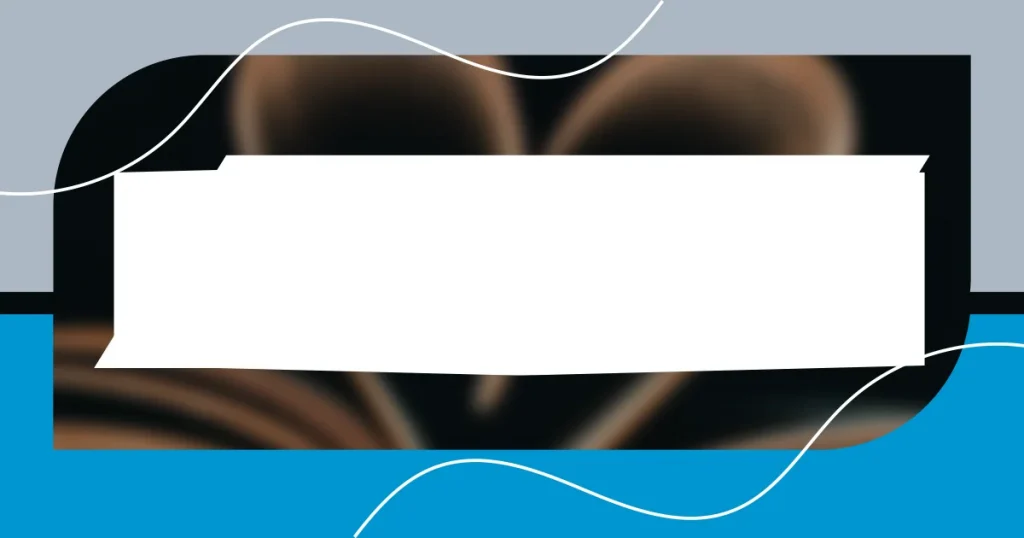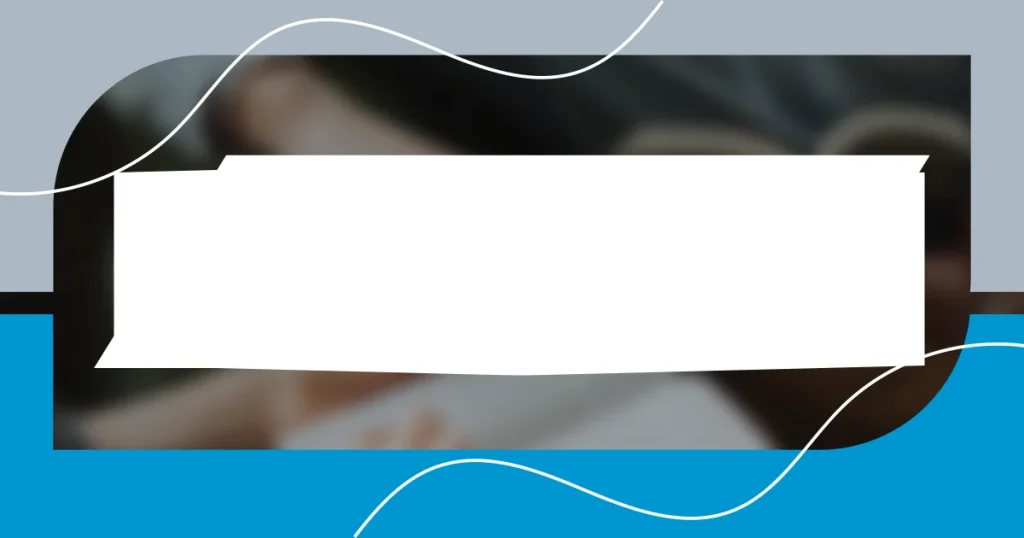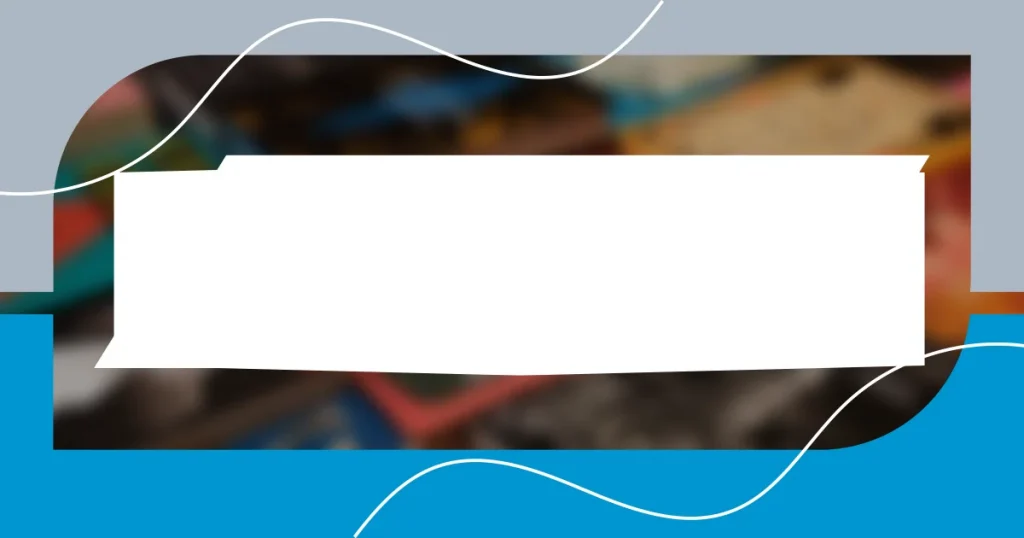Key takeaways:
- Understanding literary themes is essential as they connect narratives to human experiences, revealing deeper emotional truths and societal reflections.
- Key elements such as symbols, character actions, and settings significantly contribute to theme development, offering profound insights into characters’ motivations and societal contexts.
- Analyzing plot developments and recurring motifs can uncover broader truths about life, encouraging personal reflection and deeper engagement with the story.

Understanding literary themes
Understanding literary themes is crucial because they serve as the backbone of any narrative. I remember reading “The Great Gatsby”; the theme of the American Dream resonated deeply with me. It made me question whether that ideal is truly attainable or just an illusion we chase in our lives.
When I analyze a theme, I often reflect on how it connects to human experiences. Take the theme of love in “Pride and Prejudice,” for example. It’s not just about romantic interests; it explores societal expectations, personal growth, and the complexities of relationships. Doesn’t that mirror our own lives, where love often comes with challenges and compromises?
Themes also create a thread that ties various elements of a story together. I find it fascinating how characters’ motivations often stem from underlying themes. For instance, in “The Crucible,” fear and hysteria push individuals to their breaking points. Have you ever felt that kind of pressure in your own life? It’s this emotional connection that makes themes so powerful and relevant.

Identifying key elements
Identifying key elements within a narrative is crucial for unpacking its themes. For instance, when I read “1984” by George Orwell, the oppressive atmosphere stands out starkly, showcasing how environment shapes human experience. Such elements are not merely background; they serve as a lens through which characters interact with their themes, enhancing the story’s depth.
In my experience, symbols often carry significant weight in conveying themes. A perfect example is the green light in “The Great Gatsby.” It represents Gatsby’s unreachable dreams and the illusion of the American Dream itself, illustrating the gap between aspiration and reality. Reflecting on such symbols can reveal hidden layers in the text, enriching our understanding.
Characters’ dialogues and actions frequently echo the underlying themes as well. When I revisit “To Kill a Mockingbird,” I notice how Atticus Finch’s moral stance against prejudice sheds light on themes of integrity and justice. This nuanced portrayal resonates with me, prompting reflections on my own values and decisions in the face of societal pressures.
| Key Element | Description |
|---|---|
| Symbols | Objects or images that represent larger ideas, deepening the thematic expression. |
| Character Actions | The behaviors and decisions characters make can reveal their connections to thematic elements. |
| Setting | The environment or backdrop that influences the narrative and complements the theme. |

Exploring character motivations
When exploring character motivations, I often ask myself about the underlying desires that drive their actions. For instance, I remember feeling a strong connection to Elizabeth Bennet in “Pride and Prejudice.” Her fierce independence against societal pressures struck a chord with me, pushing me to reflect on my own choices in the face of expectations. This reveals how motivations can stem from personal experiences, transcending the page and resonating within us.
- Fear of Failure: Characters may act against their morals, driven by the anxiety of not meeting family or societal expectations.
- Desire for Acceptance: The need to belong can lead characters to compromise their values, showcasing the human desire for connection.
- Pursuit of Redemption: Motivations rooted in past mistakes can enrich a character’s journey, as they seek forgiveness or a chance to make things right.
Understanding these motivations not only deepens our connection to the story but also reflects aspects of our own lives—after all, haven’t we all had moments when we’ve acted out of fear or longing?

Analyzing plot developments
When I dive into analyzing plot developments, I pay close attention to the sequence of events and the pivotal moments that shape the narrative. For instance, in “Gone Girl,” the way the plot twists and turns keeps me on the edge of my seat, making me question everything I think I know about love and trust. These unexpected shifts often reveal deeper truths about the characters, blurring the lines between hero and villain, which adds richness to the reader’s experience.
I find it fascinating how plot developments can serve as mirrors to broader societal issues. Take “The Handmaid’s Tale” as an example; the progression of the plot reflects real-world concerns about autonomy and power dynamics. It prompts me to think—how often do we witness plotlines in fiction that resonate with current affairs, questioning our roles within them? Such connections elevate the narrative from mere storytelling to a powerful commentary on our times.
As I analyze plot developments, I often look for patterns and recurring motifs that contribute to the overall theme. In “The Catcher in the Rye,” for instance, Holden’s spiral into isolation poignantly illustrates the struggles of adolescence. This careful unfolding of his journey invites me to reflect on my own experiences of feeling lost during life transitions, reminding me that fiction often echoes our innermost struggles and emotions in profound ways.

Examining setting and context
When I examine the setting and context in a story, I often think about how the physical environment shapes the characters’ experiences. For instance, I recently reread “The Great Gatsby,” and I was struck by how the opulent setting of West Egg reflects the themes of wealth and superficiality. The lavish parties and extravagant mansions are not just backdrops—they actively influence the characters’ actions and decisions. Have you ever noticed how a simple setting can evoke certain emotions? It’s as if the place itself becomes a character in the narrative.
Context also involves the societal norms and historical backdrop against which the story unfolds. Consider “To Kill a Mockingbird”; the racially charged atmosphere of the American South during the 1930s deeply informs the characters’ struggles and moral choices. I remember feeling a mix of anger and empathy as I reflected on how these external factors can restrict personal freedom and influence moral compass. It raises a question for me: how does the context of our own lives shape our perceptions and decisions?
Finally, I find that different genres utilize setting in unique ways. In dystopian fiction, for example, the bleak environments often reflect societal decay and emotional despair. In my experience, books like “1984” don’t just tell a story; they create a chilling reality that lingers long after reading. I can’t help but wonder—how often do we overlook the power of setting in our own stories, whether they are fictional or a reflection of our lived experiences? When we start to examine the context in which narratives exist, we discover layers that contribute to the richness of the themes presented.

Utilizing thematic motifs
When I think about utilizing thematic motifs, I often find myself captivated by the recurring symbols or concepts that enhance the stories I read. For example, in “The Alchemist,” the motif of the journey symbolizes not just physical travel but also the quest for self-discovery. I remember feeling inspired by Santiago’s adventures, as they resonated with my own pursuit of dreams—reminding me that every path we take holds the potential for growth and transformation.
Motifs can weave unseen connections throughout a narrative, making me more aware of the underlying themes. I recall my experience with “The Color Purple,” where the motif of letters serves as a powerful vehicle for communication and healing. Each letter that Celie writes unlocks her voice and autonomy, demonstrating how personal expression can foster resilience. It leaves me wondering: how often do we overlook the simple yet profound elements that reflect our own struggles for voice and identity in our lives?
Diving deeper into motifs allows me to reflect on how they shape not only the characters but also the readers’ understanding of the themes. In “Lord of the Flies,” the conch shell represents civilization and order. I remember the chilling realization of its gradual destruction paralleling the boys’ descent into chaos. It makes me ponder—how do the symbols we encounter in literature mirror our own societal dilemmas? Such motifs encourage me to think critically about the world around us, transforming the reading experience into a more personal and reflective journey.

Drawing conclusions from analysis
Drawing conclusions from analysis feels like piecing together a puzzle. After examining various elements of a story, I often find myself looking for those larger truths that emerge from the details. For instance, when I analyzed “Pride and Prejudice,” I saw how the characters’ relationships reflected societal expectations of gender and class. This realization left me wondering: do our own relationships mirror societal pressures in ways we’re not even conscious of?
Once I’ve gathered insights from different aspects of a narrative, I reflect on how they interconnect to form a cohesive message. With “The Handmaid’s Tale,” I was struck by how Atwood uses language as a tool of both oppression and resistance. This duality reminded me of the power of our own words in real life—how they can uplift or belittle, depending on our intentions. It opens a floodgate of questions: how often do we consider the impact of our daily conversations on the world around us?
By synthesizing all these elements, I find that the conclusions I draw from my analysis often resonate personally. After diving into “The Kite Runner,” I was forced to confront themes of guilt and redemption, which sparked introspection about my own past decisions. It’s fascinating to think about how literature not only reflects the world but also nudges us towards self-discovery. In what ways does your reading journey lead you to reconsider your own experiences and beliefs?
















